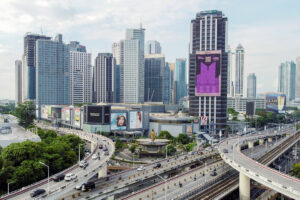ESCAP sees slower PHL growth this year
By Luisa Maria Jacinta C. Jocson, Reporter The Philippine economic growth is expected to slow to 5.5% this year amid global headwinds and persistently high inflation, the Economic and Social Commission for Asia and the Pacific (ESCAP) said in its latest report. “Post-pandemic economic growth in developing Asian and Pacific (APAC) countries weakened considerably in […]

By Luisa Maria Jacinta C. Jocson, Reporter
The Philippine economic growth is expected to slow to 5.5% this year amid global headwinds and persistently high inflation, the Economic and Social Commission for Asia and the Pacific (ESCAP) said in its latest report.
“Post-pandemic economic growth in developing Asian and Pacific (APAC) countries weakened considerably in 2022 and is expected to remain weak in 2023, amid the global economic slowdown, unprecedented inflation and uncertainty brought about by the war in Ukraine,” Armida Salsiah Alisjahbana, Under-Secretary-General of United Nations and ESCAP Executive Secretary said in the “Economic and Social Survey of Asia and the Pacific 2023” report.
ESCAP’s latest estimate is lower than the 6.7% gross domestic product (GDP) growth forecast it gave in April last year. This is also below the government’s 6-7% target and slower than the 7.6% expansion in 2022.
Based on ESCAP’s estimates, the Philippines will be the second-fastest growing economy in Southeast Asia this year, alongside Cambodia (5.5%) and just behind Vietnam (6.3%).
“The overall economic performance in developing countries in APAC is likely to remain weak in 2023 to 2024 amid global economic slowdown, elevated inflation across the board and war-induced uncertainty,” Hamza Ali Malik, ESCAP director of the Macroeconomic Policy and Financing for Development division, said in a virtual briefing discussing the report on Wednesday.
For 2024, ESCAP sees the Philippine economy expanding by 5.7%, below the 6.5-8% target set by the government.
Meanwhile, ESCAP sees Philippine inflation at 4.3% this year, higher than its earlier forecast of 3%. It expects inflation to ease to 3% in 2024.
The central bank forecasts that full-year inflation will average 6% this year, before slowing to 2.9% in 2024.
“The impact of higher interest rates in controlling the elevated rate of inflation is not expected to materialize fully in 2023. Furthermore, positive economic developments, such as the opening of the Chinese economy in 2023, are likely to keep inflation under pressure; increases in pent-up demand, however, may in turn lead to surges in commodity and energy prices,” ESCAP said.
The report also cited weakened currencies, higher import costs, and natural disasters, such as frequent typhoons in the Philippines, as drivers of inflation.
To tame inflation, the BSP raised interest rates by 425 basis points (bps) since May 2022. This brought the policy rate to 6.25%, the highest in nearly 16 years.
Meanwhile, ESCAP expects growth in developing APAC economies to average 4.2% this year, lower than the 5% estimate it gave earlier.
“However, this outlook remains fraught with uncertainty and is uneven across the region. In addition to declining exports, the growth prospects are clouded by the extent of expected monetary policy tightening in the major developed economies,” it said.
ESCAP also sees inflation in the region hitting 5.9% this year, higher than its previous forecast of 4.1%.
“Inflation is expected to remain at the elevated level of 5.9% in 2023. Although both demand and supply factors are responsible for high inflation in most economies, it is difficult to pin down their relative contribution. Likely upward pressure on wages due to high inflation, and thus inflationary expectations, cannot be ignored either,” the report said.
It also noted that central banks in the region must “balance the management of expectations about inflation amid supply driven factors while they minimize the adverse impacts of higher interest rates on the prospects for economic recovery.”
For 2024, ESCAP expects GDP growth in the region to rebound to 4.7%, while inflation is seen to ease to 4.4%.
DEBT SUSTAINABILITY
Meanwhile, ESCAP said that there is a need to implement better fiscal and debt management amid increasing interest rates and the looming global economic slowdown.
“As fiscal firepower is shrinking in the APAC region, it is time to rethink the relationship between public debt and development financing. The view that high debt levels are necessarily detrimental to economic growth has been challenged in recent years. On the other hand, development deficits and climate risks, if left unaddressed, will have serious implications for growth and the sustainability of public finance,” ESCAP said.
According to estimates by ESCAP, APAC developing countries would require an average annual investment of $1.5 trillion, an additional 5% of the region’s 2018 GDP in order to meet the sustainable development goals (SDG) target by 2030.
“The bulk of this would have to come from public resources. The requirements have certainly increased since then, especially for least developed countries. Climate-related financing needs will also put significant strain on public finances in the region. Importantly, countries most vulnerable to climate change and with the highest development deficits have the most limited fiscal space,” it added.
ESCAP also cited studies that showed there is no consensus on the “optimal level of public debt.”
One study showed there was a “significant and positive impact of public debt” on GDP growth in six ASEAN countries from 1995-2015, specifically in Indonesia, Malaysia, the Philippines, Singapore, Thailand and Vietnam.
ESCAP Economic Affairs Officer Vatcharin Sirimaneetham said that debt can be a “powerful tool for development if used judiciously and with a long-term horizon.”
Mr. Sirimaneetham said that current methodologies on debt sustainability are often short-term, which leads to the government cutting on spending. This results in unemployment and limited government access to financial resources for SDGs, among others.
He also cited other ways to boost fiscal space, such as ramping up revenues.
“Public revenue generation by strengthening tax revenue collection, including through direct taxes. Also raising non-tax revenues and scaling up development transfers now rather than providing debt relief later,” he added.
The ESCAP report said that “sizable revenue potentials can be realized through the broadening of the tax base and overall improvements in tax administration.”
“Indeed, modernizing and rationalizing tax systems (Cambodia, Maldives, Myanmar, Nepal, the Philippines), introducing new broad-based taxes (Maldives, Myanmar, Samoa, Tonga), incorporating the informal sector and small and medium-sized enterprises into the formal tax regime (Cambodia), improving tax and customs administration (Armenia, Cambodia, Myanmar, Nepal, the Philippines) and removing excessive tax exemptions (the Philippines) were among the major drivers behind the most impressive country-level revenue increases in recent years. This momentum is likely to continue,” it added.
In the Philippines, the National Government’s (NG) outstanding debt hit a record-high P13.75 trillion as of end-February.
The country’s debt-to-GDP ratio stood at 60.9% as of end-December, still slightly above the 60% threshold considered manageable by multilateral lenders for developing economies.
The government aims to cut the debt-to-GDP ratio to less than 60% by 2025, and further to 51.5% by 2028.























